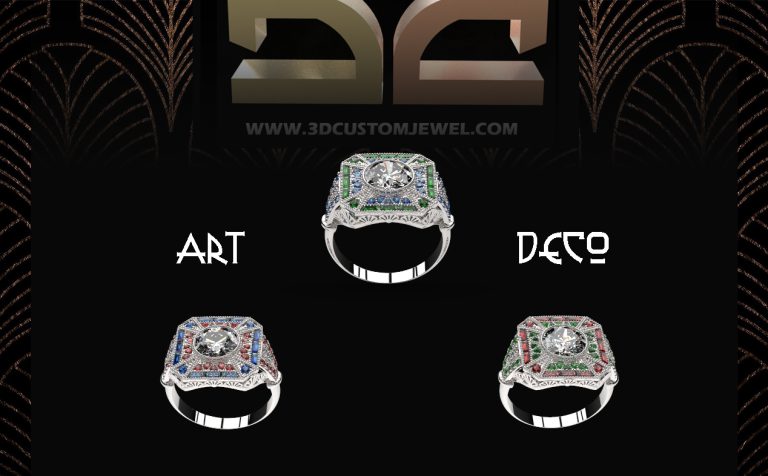Esta sortija esta inspirada por el art deco.
El art déco (también art decó o incluso art deco) fue un movimiento de diseño popular a partir de 1920 hasta 1939 (cuya influencia se extiende hasta la década de 1950 en algunos países) que influyó las artes decorativas tales como arquitectura, diseño interior, y diseño gráfico e industrial, también a las artes visuales tales como la moda, pintura, grabado, escultura y cinematografía.
Después de la Exposición Universal de 1900 de París, varios artistas franceses (Hector Guimard, Eugène Grasset, Raoul Lachenal, Paul Follot, Maurice Dufrene y Emile Decour) formaron un colectivo formal dedicado a las artes decorativas de vanguardia. En 1925 organizaron la Exposition Internationale des Arts Décoratifs et Industriels Modernes (Exposición Internacional de Artes Decorativas e Industriales Modernas) en París, y se llamaron a sí mismos los modernos; en realidad, el término art déco se acuñó en la retrospectiva titulada «Les Années 25», llevada a cabo en París en el Musée des Arts Décoratifs (Museo de Artes Decorativas) del 3 de marzo al 16 de mayo de 1966;1? el término es por lo tanto un apócope de la palabra francesa décoratif.
Para finalizar recogemos dos definiciones del Art Déco.
Alastair Duncan, en la Enciclopedia of Art Deco, recoge la siguiente definición:
“No es fácil definir las principales características del Art Déco, porque el estilo atrajo una multitud de diversas y, con frecuencia, contradictorias influencias. Muchas de ellas vinieron de los estilos pictóricos de vanguardia de los tempranos años del siglo, como el Cubismo, el Constructivismo Ruso y el Futurismo Italiano -abstracción, distorsión y simplificación- todos evidentes en las artes vernáculas decorativas Art Deco. Pero estos no fueron todos: una examen del repertorio de motivos estandarizados del estilo tales como -racimos de flores estilizadas, jóvenes doncellas, geométricos y ubicuos frutos- revelan influencias del mundo de la alta moda, de Egipto, el Oriente, la África tribal y de los Ballets Rusos de Diaghilev. A partir de 1925 el creciente impacto de la máquina puede ser discernido en repetidas y superpuestas imágenes, o más tarde, en los treinta, por formas modernizadas derivadas de principios aerodinámicos. Todo esto resultó en una elevada amalgama de complejas influencias artísticas, descritas desafiantemente por una simple frase, el término Art Déco”.
Fancy Susan Sternau en la obra Art Déco lo describe de la siguiente forma:
“Desarrollado en París y más tarde fomentado en Hollywood como el estilo de las estrellas, el Art Deco hizo la transición, en unos pocos años, de un primarío estilo francés a un universalmente entendido símbolo del glamour. Art Deco, es un conveniente término usado para describir arte decorativo en el período entre las dos guerras mundiales, y refiere a un estilo que es clásico, simétrico y rectilíneo. Como movimiento se desarrolló durante los años 1908 a 1912 y alcanzó un alto punto de 1925 a 1935. Este estilo fue el producto de influencias tan diversas como el Art Nouveau, Cubismo, el Bauhaus y el arte de Egipto, el Oriente, “Africa y las Américas”.
This #ring is inspired by Art Deco.
Art Deco was a popular #design movement from 1920 to 1939 (whose influence extends until 1950 in some countries) that influenced decorative arts such as architecture, interior design, and graphic and industrial design, as well as visual #arts such as #fashion, painting, #engraving, #sculpture and filmmaking.
After the Universal Exposition of 1900 in Paris, several French #artists (Héctor Guimard, Eugene Grasset, Raoul Lachenal, Paul Follot, Maurice Dufrene and Emile Decour) formed a formal collective dedicated to the avant-garde #decorative #arts. In 1925 they organized the Exposition Internationale des Arts. Décoratifs et Industriels Modernes (International Exhibition of Modern Decorative and Industrial Arts) in Paris, and called themselves “the modern ones”; actually, the term art #deco was coined in the retrospective entitled “Les Années 25”, held in Paris at the Musée des Arts Décoratifs (Museum of Decorative #Arts) from March 3 to May 16, 1966; the term is therefore an apocope of the French word décoratif.
Finally, let us quote two definitions of Art Deco.
Alastair Duncan, defines Art deco as follows:
“It is not easy to define the main characteristics of Art Deco, because the #style attracted a multitude of diverse and often contradictory influences. Many of them came from the avant-garde pictorial #styles of the early years of the century, such as Cubism, Russian Constructivism and Italian Futurism – abstraction, distortion and simplification – all evident in Art Deco decorative vernacular arts. But these were not all: a repertoire examination of standardized motifs of style such as stylized #flower #bouquets, young maidens, geometric and ubiquitous fruits, reveal influences from the world of high fashion, Egypt, the Orient, tribal Africa and the Russian Ballets of Diaghilev. From 1925 the growing impact of the machine can be discerned in repeated and superimposed images, or later in the thirties, by modernized forms derived from aerodynamic principles. All this resulted in a high amalgam of complex artistic influences, described defiantly by a simple phrase, the term Art Deco”.
Nancy Susan Sternau in her book “Art Deco: Flights of #Artistic Fancy” describes it as follows:
“Developed in Paris and later fostered in Hollywood as the style of the #stars, Art Deco made the transition, in a few years, from a primary French style to a universally understood symbol of glamor. Art Deco is a convenient term used to describe decorative art in the period between the two world wars, and refers to a style that is #classic, #symmetrical and rectilinear. As a movement it as a movement it developed during the years 1908 to 1912 and reached a high point from 1925 to 1935. This style was the product of influences as diverse as Art Nouveau, Cubism, the #Bauhaus and Egyptian art, the East, Africa and the Americas”


